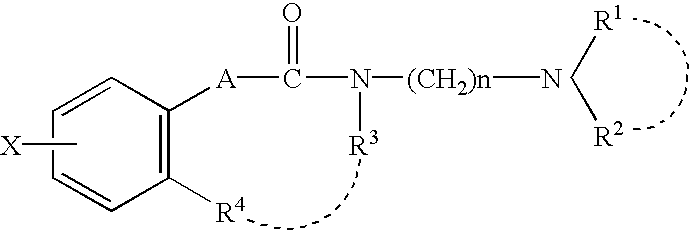Beta-amyloid protein production/secretion inhibitors
- Summary
- Abstract
- Description
- Claims
- Application Information
AI Technical Summary
Benefits of technology
Problems solved by technology
Method used
Image
Examples
reference example 2
Methyl 6-hydroxynicotinate
To methanol (100 ml) in an ice bath was added thionyl chloride (16 ml) followed by addition of 6-hydroxynicotinic acid (10 g).
The reaction mixture was warmed to room temperature and stirring was continued for sixty hr. After concentration, the reaction mixture was diluted with saturated aqueous sodium bicarbonate and extracted with the combined mixture of THF and ethyl acetate.
The organic layer was washed with water and saturated aqueous sodium chloride, dried, and concentrated. The residue was recrystallized from THF / diisopropyl ether to obtain the titled compound (3.4 g).
m.p.:164-166.degree. C.
reference example 3
Methyl 1-(4-biphenylylmethyl)-1,6-dihydro-6-oxo-3-pyridinecarboxylate
##STR17##
A mixture of methyl 6-hydroxynicotinate (3 g), 4-biphenylylmethyl bromide (5.8 g), potassium carbonate (8.2 g), and DMF (30 ml) was stirred at room temperature for 12 hr. The reaction mixture was diluted with water and extracted with ethyl acetate. The organic layer was washed with water and saturated aqueous sodium chloride sequentially and concentrated. The resulting crystals were washed with diisopropylether and recrystallized from ethyl acetate / hexane to obtain the titled compound (5.1 g).
m.p.:130-133.degree. C.
reference example 4
1-(4-Biphenylylmethyl)-1,6-dihydro-6-oxo-3-pyridinecarboxylic Acid
##STR18##
To a solution of methyl 1-(4-biphenylylmethyl)-1,6-dihydro-6-oxo-3-pyridinecarboxylate (4.5 g) in methanol (50 ml) / THF (50 ml) was added dropwise 1N aqueous sodium hydroxide (28 ml) at room temperature. The reaction mixture was stirred at room temperature for 3 hr and concentrated. The residue was diluted with 1 N hydrochloric acid (30 ml) and extracted with a mixed solvent of ethyl acetate and THF. The organic layer was washed with saturated aqueous sodium chloride, dried, and concentrated. Diisopropylether was added to the residue and the resulting crystals were collected by filtration to obtain the titled compound (4.2 g).
m.p.: 245-250.degree. C.
PUM
| Property | Measurement | Unit |
|---|---|---|
| Aromaticity | aaaaa | aaaaa |
Abstract
Description
Claims
Application Information
 Login to View More
Login to View More - R&D
- Intellectual Property
- Life Sciences
- Materials
- Tech Scout
- Unparalleled Data Quality
- Higher Quality Content
- 60% Fewer Hallucinations
Browse by: Latest US Patents, China's latest patents, Technical Efficacy Thesaurus, Application Domain, Technology Topic, Popular Technical Reports.
© 2025 PatSnap. All rights reserved.Legal|Privacy policy|Modern Slavery Act Transparency Statement|Sitemap|About US| Contact US: help@patsnap.com



